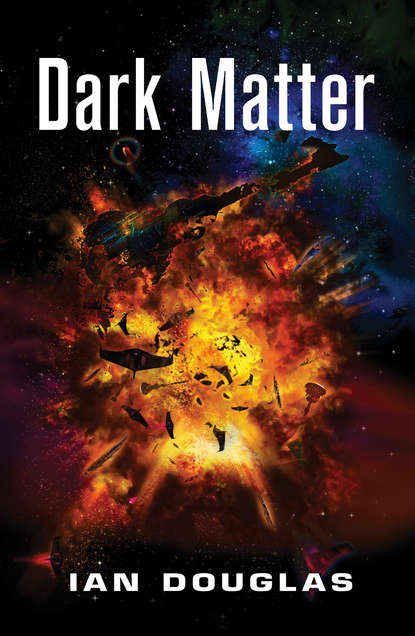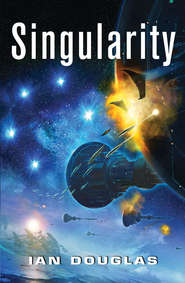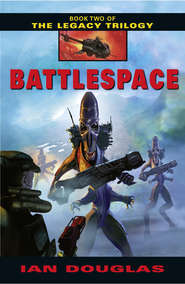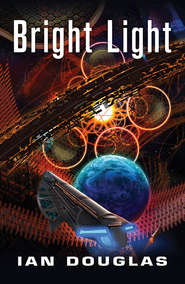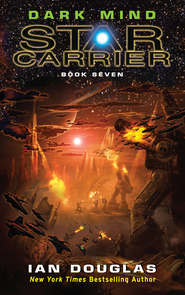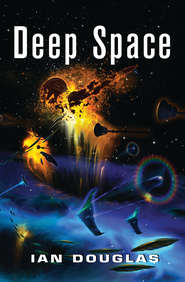По всем вопросам обращайтесь на: info@litportal.ru
(©) 2003-2024.
✖
Dark Matter
Настройки чтения
Размер шрифта
Высота строк
Поля
Omega Centauri
1016 hours, TFT
“I wish I knew what the hell we were looking at.”
Rear Admiral Trevor “Sandy” Gray stared at the deck-to-overhead viewall in America’s officers’ lounge. He’d been staring into the cosmic panorama every chance he got for three days, now, and was no closer to understanding what he was seeing than he’d been when the task force arrived.
It was, he thought, unimaginably, sublimely beautiful.
It was also utterly mysterious, quite possibly completely and forever beyond human understanding.
The Omega Centauri globular star cluster was the largest such known within the Milky Way galaxy. Some 230 light years across, that teeming, crowded sphere of 10 million closely packed stars was known to be the stripped-down core of a small, irregular galaxy cannibalized by the Milky Way perhaps 800 million years before. That long ago, Earth had been inhabited solely by single-celled microorganisms that were just on the point of discovering sex, but a highly advanced collective of numerous technic species had already been stellarforming their galaxy. Among other things, they’d created a rosette of six supergiant stars, each forty times the mass of Earth’s sun, rotating them about a common center of gravity in a way—it was now believed—that had opened pathways to other places in space . . . and almost certainly other times as well.
That galaxy, called the N’gai Cloud by its inhabitants, had been devoured and shredded, its inhabited worlds scattered. At about the same time, the N’gai’s starfaring cultures, collectively called the ur-Sh’daar, had undergone a technological singularity . . . a technic metamorphosis that had transformed them far beyond the ken of those left behind.
The remnant left had, with the passage of 876 million years, become the Sh’daar, mysterious galactic recluses who dominated some thousands of technic species across the galaxy, and who’d become the enemies of Humankind.
That much, at least, had been learned by America’s battlegroup under the command of Admiral Koenig, which had used an ancient, artificial singularity generator, a massive, fast-spinning cylinder a kilometer across called a TRGA, to travel into the remote past and confront the Sh’daar within their home galaxy. Communications of a sort had been established, a kind of truce declared; electric downloads had revealed the ur-Sh’daar, and the fear-crippled, broken relics that eventually had become the modern Sh’daar.
That had been almost twenty years ago. Gray, at the time, had been a Navy lieutenant and a fighter pilot. Before that he’d been a monogie prim—the words were not compliments—from the half-sunken ruins of Manhat.
God, he’d come a long way since then.
Captain Sara Gutierrez was one of two black-uniformed women standing next to Gray in the officers’ lounge. “It’s so terrible.”
“Terrible? In what way?”
“You can see where they’ve destroyed whole swaths of the cluster. Destroyed the stars. What kind of monsters are we dealing with here?”
“Very, very powerful ones,” the other woman observed. She was Commander Laurie Taggart, America’s chief weapons officer.
The Omega Centauri cluster had been partially disassembled. Needle-slender, impossibly long black streaks could be seen now, stretching out from that artificial central sun, gaps and swaths among the cluster’s tightly packed stars where hundreds of thousands of suns had been moved or destroyed.
The sky at the cluster’s center was dominated by a vast and hazy field of blue-violet light, by enigmatic structures that themselves seemed to be made of light, by impossibly vast constructs of beams and platforms and spheres and connectors of pale, blue mist. Many of those structures appeared bent in disturbing ways that hurt the eye. Like a lithograph by M. C. Escher, many of those shapes did not appear to obey the usual laws of three-dimensional geometry. In the distance, an artificial sun, a star fifty times more massive than Sol created by dragging a number of the cluster’s stars together and merging them, illuminated the central reaches of Omega Centauri with a harshly actinic glare.
“I think they must be adding on to the Rosette,” Gray said. “We may learn more when our recon probe gets in closer.”
What was the name of the VQ-7 Shadowstar pilot they’d just launched? Walton, that was it. His in-head provided the name and service record access. Young kid, twenty-five . . . four years in the Navy, two wives and a husband back in Omaha . . .
And he was hurtling now into the very heart of strangeness.
Deep within Omega Centauri’s core was the enigmatic Black Rosette, an obviously artificial arrangement of six black holes, each some forty times the mass of Sol, all orbiting their common center of gravity in a tight, tight gravitational embrace. If you were close enough to see them, the individual black holes blurred into an indistinct, smoky ring by the speed of their orbit—something like 26,000 kilometers per second.
Eight hundred seventy-six million years ago, the Rosette had been the Six Suns, six blue supergiant stars in a gravitationally balanced circle apparently created by the vanished ur-Sh’daar. But stars with forty times Sol’s mass don’t live for long on the cosmic scale of things . . . a few tens of millions of years at most. Long ago, the Six Suns had exploded, their cores collapsing into black holes, point sources of incredibly powerful gravitational forces. Now, they were the Black Rosette. As they circled their common center, their movement through space and their combined gravitational fields sharply distorted spacetime, creating a kind of stargate, one far larger and far more powerful than the enigmatic TRGA cylinders that had been discovered elsewhere in the galaxy.
The truly chilling import of what he was seeing, Gray thought, wasn’t so much the destruction of so many suns as it was the fact that the Rosette Aliens, whatever they were, appeared to be building their colossal stellarchetecture in time as well as in space.
The light from those changes in the starfield could not possibly have reached this point in space yet.
Somehow, the Rosette Aliens were disassembling the cluster and weaving their structures through time as well as space. The best guess the physics team on board America had been able to come up with so far was that the aliens had so distorted the local spacetime continuum that they’d actually changed Omega Centauri’s history. Those black swaths and gaps now visible among the stars had not been created within the past four months . . . but as of now had been there for well over a century, long enough for the light recording those changes to have traveled this far.
And that fact alone spoke volumes about the Builders’ power.
“I wonder if any of those stars they destroyed had worlds?” Gutierrez said. “Inhabited worlds?”
“Not likely,” Gray replied. “These are stars from an ancient galactic core, remember. Population Two, most of them. That means they’re metal poor, almost entirely hydrogen, and very, very old. No heavy stuff—no iron or silicon or anything else—for building planets.”
“It still seems . . . arrogant,” Taggart observed. “Just pop in out of nowhere and start taking apart a star cluster! Like they own the place!”
“Like the stargods?” Gray said, smiling gently.
“Fuck you,” Taggart said, then added, “Sir.”
Gray accepted the vulgar familiarity with a chuckle. He had deserved it. Laurie Taggart was an AAC, an Ancient Alien Creationist, a follower of a religion that boasted perhaps 20 million official adherents Earthside, and millions more who believed the basic dogma without belonging to the church. The AACs held that Earth had been visited in the remote past by technologically advanced aliens who, among other things, had tinkered with the genome of certain native bipeds to create Homo sapiens.
Gray couldn’t buy that himself. The AAC mythology painted the Ancient Aliens as interstellar busybodies who were so . . . so human, building pyramids here, creating alien-human hybrids there, nuking Sodom and Gomorrah or whipping up a planetary flood to drown the human population out of existence when they got pissed off.
If there were stargods, Gray thought, they would be more like those Builders out there, annihilating stars without a second thought, rewriting the time line of an entire galactic cluster, and those were beings so advanced that they might not even notice mere Humankind. He and Taggart had discussed the idea more than once, and he enjoyed lightly tweaking her about it now and again.
But the encounter with these cluster-reshaping beings during the past few days had profoundly shaken her, he knew. It might be a good idea not to tease her about her religion.
In any case, that sort of thing nowadays was considered socially unacceptable. The White Covenant, a set of international agreements in place since the late twenty-first century, mandated only that you weren’t allowed to proselytize or forcefully convert others when it came to religion . . . but after three and a half centuries most people took that to mean a prohibition on any discussion of religious belief or disbelief. At the very least, such a discussion was considered rude. Bull sessions among friends were okay, sure . . . but in a professional setting like this . . . not so much.
That alien vista outside of America, Gray knew, was wearing at everyone in the squadron. Gnawing at them. The worst of it was knowing that the aliens had already destroyed the research ship RSV Endeavor and two escorting destroyers, Miller and Herrera, killing over fifteen hundred personnel on board. They’d been obliterated in an instant, four months ago, when something had come through the Rosette from . . . somewhere else. The destruction had been captured on video taken by an HVK-724 high-velocity scout-courier robot, which had subsequently returned the images to Earth.
Gray and his staff had spent a lot of hours studying those images. The alien vessels, if that’s what they were, appeared to be featureless, mirror-polished silver ovoids ranging in size from a few meters to nearly a kilometer in length. There was no sign of them now, though . . . only those enigmatic and impossible structures of light.
“As for what we’re looking at, sir,” Taggart continued quietly, “I think we have to assume that they’re using the Rosette as a transit gate from wherever they came from. We know that there are many possible paths through the spacetime opening.”
“One octillion,” Gray said. “Ten to the twenty-seven distinct spacetime pathways. Assuming that the Black Rosette is the same as the Six Sun rosette built eight hundred seventy-six million years ago.”
“The number may be very much larger now,” a voice said in their heads, speaking through their in-head circuitry. The AI that ran America was always there, listening, and very occasionally putting in a word or two.
“Why is that?” Gutierrez asked.
“The black holes of the Rosette in Omega Tee-Prime distort spacetime between them to a far greater degree than was true for the Six Suns of Tee-Sub. The actual number of distinct spacetime pathways through Tee-Prime may exceed one centillion—or ten to the three hundred third power—essentially, and for all intents and purposes, nearly infinite.”
And that was a sobering thought.
Omega Tee-Prime was the shorthand term for the Omega Centauri cluster today, time now, in the year 2425. Omega Tee-Sub, on the other hand, was shorthand for the unwieldy T-0.876gy, a clumsy term pronounced “Tee sub minus zero point eight seven six gigayear” and identifying the N’gai Cloud of the ur-Sh’daar, 876 million years in the past.
If the Rosette Aliens were busily rewriting the cluster’s immediate past, Gray thought glumly, it might be necessary to come up with some new spacial-temporal terminology as well. Time travel made everything so damnably complicated.
And yet, the ability to reshape time was an obvious follow-on to the ability to warp space. Ever since Einstein, physicists had known that space and time were not distinct entities, but dimensional aspects of each other, of spacetime. Human ships used projected, artificial gravitational singularities to move themselves through space; in theory, it should be possible to do the same to move through time, though that would require a lot of energy—more energy than even a star carrier’s quantum power tap could supply. In another few centuries, perhaps . . .
But the Black Rosette Aliens were doing it now.
From America’s current position, the Black Rosette was made invisible by distance, but close-up passes by the Endeavor before her destruction had shown tantalizing glimpses of alien scenes, alien starfields peeking out through the lumen of that hazy circle of rotating singularities.





